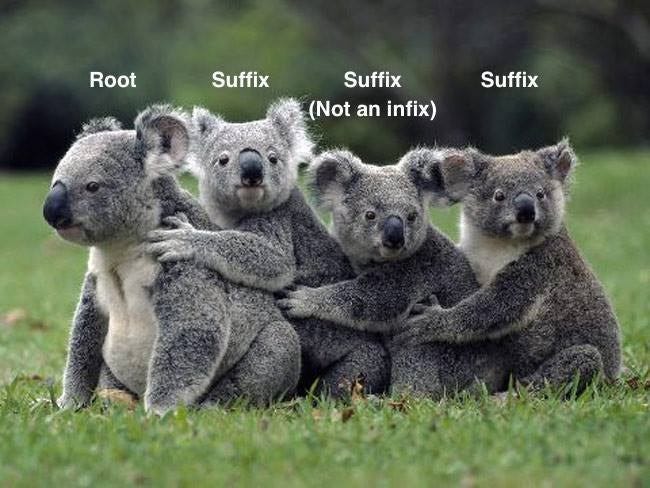Introduction to Morphology - Resource Guide 3
Today's newsletter is our third Resource Guide, and it's for teaching an introduction to morphology.
Why this topic is useful
Morphology is the study of the internal structure of words. Studying morphology can help us understand how different languages create new words and modify existing words. We'll look at how words go together in our resource guide to constituency next Friday.
Introductory Videos & Podcasts
The Ling Space: Morphemes
A fun, quick introduction to morphology with a person explaining the concepts on-screen with some light graphics overlaid to illustrate concepts. Length: 7m11s. Captions: human-edited (English).TheTrevTutor: Free and Bound Morphemes, Affixes
A more in-depth introduction to morphemes and how they appear in English. Voice-over presented with on-screen graphics to help visualize concepts as they’re explained. Length: 13m14s. Captions: auto-generated.Lingthusiasm Episode 16: Learning parts of words - Morphemes and the wug test
Segment: 4:24-6:25. An explanation of the famous wug test, including its history, purpose, and execution. Transcript available.ASL Linguistics: ASL Morphology
An overview of free and bound morphemes and how this concept applies to American Sign Language. Explained with slides and voiceover. Length: 10m16s. Captions: human-edited (English).
Derivational & Inflectional Morphology
The Ling Space: What Kinds of Pieces Do We Use to Build Words? Derivational and Inflectional Morphology
Explains how to tell the difference between different types of morphemes and how we use them to build words. A good follow-up to their introductory morphology episode listed above. Length: 8m50s. Captions: human-edited (English).TheTrevTutor: Derivational and Inflectional Morphemes, and Morphological Changes
This video uses on-screen graphics to explain about, and show examples of, different types of morphemes and morphological changes. Includes internal change, suppletion, reduplication, and stress differences. Length: 11m52s. Captions: auto-generated.The Language Code: Episode 6 : Morphology - Inflectional vs derivational
A short explanation of how English uses morphemes to build words, shown with explanations written on-screen. Similar to how it might be explained in a classroom setting. Length: 6m58s. Captions: auto-generated.
Word-Building
Tom Scott: Long and Short Words: Language Typology
A short, engaging explanation of how different languages engage in word-building with an on-screen narrator and graphics. Length: 4m36s. Captions: human-edited (English, French, German, Portuguese, Russian, Slovakia, Spanish, Thai).TheTrevTutor: Word Creation
This video explores different processes used in English to create words, including compounds, clipping, blending, back-formation, acronyms/initialisms, and coinage. Length: 7m56s. Captions: auto-generated.
Blog posts/diagrams
All About Linguistics: What is Morphology?
A summary of morphology, including diagrams and examples of free/bound morphemes and simple/complex morphology trees.Morphology 5: Word Analysis & Affixation
An explanation with diagrams of how English uses morphemes to create words. Includes short review questions and activities throughout lessons.Morphology: Prefixes, Suffixes, Roots
Lists of morphemes in English organized by position in words and then by category.
Textbook
Essentials of Linguistics, Chapter 6 (Anderson)
Chapter 6 of this open access textbook covers morphology, including words and morphemes (§6.1), allomorphs (§6.2), inflectional morphology (§6.3), derivational morphology (§6.4) and a chapter on inflectional morphology in some Indigenous languages of Canada (§6.5). Includes video for the sections on inflectional and derivational morphology. Captions: human-edited.
Activities
Morphology Exercises
A series of mini-quizzes that have you break down English words into their morphemes, identify inflectional and derivational morphemes, and identify morphemes in another language given a list of phrases in that language and their translations.What Is Morphology?
An explanation with text and video of how to draw word trees.
Something fun
All the resources listed above are excellent, but the best way to teach morphology is using koalas. Click through to the link for images to cover infixes and circumfixes as well.

All Things Linguistic via Astronautical Linguist.
In other news
This week we had our first 3 Links guest-contributed post. Thanks Rebecca Woods (Newcastle University) for the 3 Links for Semantics and Pragmatics! If you know of three (or even just one!) great linguistics resource online you can use this form to let us know. Sharing (resources, not personal space) is caring.
See you on Monday for 3 Links about psycholinguistics, and stay tuned for next Friday's Resource Guide on constituency.
Kate, Lauren, Gretchen and Liz.
This Resource Guide is also available on mutualintelligibility.substack.com (where you can subscribe for email updates to future issues), and as a google doc or pdf.
About Mutual Intelligibility
Mutual Intelligibility is a project to connect linguistics instructors with online resources, especially as so much teaching is shifting quickly online due to current events. It's produced by Lauren Gawne and Gretchen McCulloch, with the support of our patrons on Lingthusiasm. Our 3 Links editor is Liz McCullough, and our Resource Guide contributor is Kate Whitcomb (Layman's Linguist).
The newsletter consists of 3 Links on a topic on Mondays and Wednesdays and longer Resource Guides on Fridays, both of which are free and will always remain free, but if you have a stable income and find that they’re reducing your stress and saving you time, we're able to fund these because of the Lingthusiasm Patreon and your contributions enable us to fund more guides, more quickly.
Here’s where you can tell us which topics would be useful for you. The more requests we get for a specific topic, the more it helps us prioritize resources that will help the most people.
Here’s where you can send us links (of either things you’ve made or have found useful) for potential inclusion in future newsletters. You can send a single link, or a set of three which may become a 3 Links guest-post! (With credit to you.)
If you have other comments, suggestions, or ideas of ways to help, please email mutual.intellig@gmail.com

This Resource Guide was created by Mutual Intelligibility and is licensed under a Creative Commons Attribution 4.0 International License.



